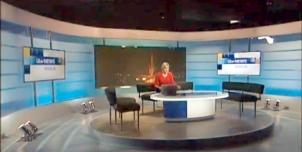Full Freeview on the Tacolneston (Norfolk, England) transmitter
| Google Streetview | Google map | Bing map | Google Earth | 52.518,1.139 or 52°31'6"N 1°8'22"E | NR16 1DW |
The symbol shows the location of the Tacolneston (Norfolk, England) transmitter which serves 330,000 homes. The bright green areas shown where the signal from this transmitter is strong, dark green areas are poorer signals. Those parts shown in yellow may have interference on the same frequency from other masts.
This transmitter has no current reported problems
The BBC and Digital UK report there are no faults or engineering work on the Tacolneston (Norfolk, England) transmitter._______
Digital television services are broadcast on a multiplexes (or Mux) where many stations occupy a single broadcast frequency, as shown below.
64QAM 8K 3/4 27.1Mb/s DVB-T MPEG2
DTG-12 QSPK 8K 3/4 8.0Mb/s DVB-T MPEG2
H/V: aerial position (horizontal or vertical)
Which Freeview channels does the Tacolneston transmitter broadcast?
If you have any kind of Freeview fault, follow this Freeview reset procedure first.Digital television services are broadcast on a multiplexes (or Mux) where many stations occupy a single broadcast frequency, as shown below.
64QAM 8K 3/4 27.1Mb/s DVB-T MPEG2
DTG-12 QSPK 8K 3/4 8.0Mb/s DVB-T MPEG2
H/V: aerial position (horizontal or vertical)
Which BBC and ITV regional news can I watch from the Tacolneston transmitter?

BBC Look East (East) 0.8m homes 3.2%
from Norwich NR2 1BH, 16km northeast (37°)
to BBC East region - 27 masts.
70% of BBC East (East) and BBC East (West) is shared output

ITV Anglia News 0.8m homes 3.2%
from NORWICH NR1 3JG, 16km northeast (38°)
to ITV Anglia (East) region - 26 masts.
All of lunch, weekend and 80% evening news is shared with Anglia (West)
Are there any self-help relays?
| Gt Yarmouth | Transposer | 1 km S town centre | 30 homes |
| Lowestoft (2) | Transposer | Rotterdam Rd | 125 homes |
How will the Tacolneston (Norfolk, England) transmission frequencies change over time?
| 1950s-80s | 1984-97 | 1997-98 | 1998-2011 | 2011-13 | 2013-18 | 2013-17 | 17 Jul 2018 | ||
| VHF | C/D E | C/D E | C/D E | E | E T | W T | W T | ||
| C3 | BBCtvwaves | ||||||||
| C31 | com7 | com7 | |||||||
| C32 | _local | ||||||||
| C37 | com8 | com8 | |||||||
| C39 | +ArqB | +ArqB | ArqB | ||||||
| C40 | BBCA | ||||||||
| C42 | SDN | SDN | SDN | SDN | |||||
| C43 | D3+4 | ||||||||
| C45 | ArqA | ArqA | ArqA | ArqA | |||||
| C46 | BBCB | ||||||||
| C50tv_off | BBCB | BBCB | |||||||
| C52tv_off | C5waves | C5waves | |||||||
| C55tv_off | BBC2waves | BBC2waves | BBC2waves | -BBCA | -BBCA | -BBCA | com7tv_off | ||
| C56tv_off | COM8tv_off | ||||||||
| C57tv_off | LNR | LNR | |||||||
| C59tv_off | ITVwaves | ITVwaves | ITVwaves | -D3+4 | -D3+4 | -D3+4 | |||
| C62 | BBC1waves | BBC1waves | BBC1waves | BBCB | |||||
| C65 | C4waves | C4waves | C4waves |
tv_off Being removed from Freeview (for 5G use) after November 2020 / June 2022 - more
Table shows multiplexes names see this article;
green background for transmission frequencies
Notes: + and - denote 166kHz offset; aerial group are shown as A B C/D E K W T
waves denotes analogue; digital switchover was 9 Nov 11 and 23 Nov 11.
How do the old analogue and currrent digital signal levels compare?
| Analogue 1-4 | 250kW | |
| SDN, ARQA, ARQB, BBCA, D3+4, BBCB | (-4dB) 100kW | |
| com7 | (-9.6dB) 27.4kW | |
| com8 | (-10.2dB) 24kW | |
| Mux 1*, Mux 2*, LNR | (-14dB) 10kW | |
| Mux A*, Mux B*, Mux C*, Mux D* | (-17dB) 5kW | |
| Analogue 5 | (-18dB) 4kW |
Local transmitter maps
Tacolneston Freeview Tacolneston DAB Tacolneston TV region BBC East Anglia (East micro region)Which companies have run the Channel 3 services in the Tacolneston transmitter area
|
|
Tuesday, 17 July 2018
H
Hardy8:54 AM
The tv authorities in Britain and the continent are restricted in the available frequencies and power they can use by agreements which have decided to take over the top end of what was the tv bands for new mobile services. British transmitters cant just increase the power to cover all areas because that would interfere with continental and Irish reception . And the foreign tranmitters would have to increase too which in turn would interfere with British reception. The least watched channels (especially HD that takes up more channel room) are the ones that get squeezed into the low power end . On many transmitters such as Sudbury these channels are already not transmitted. And I predict they will go from all transmitters after 2020.
| link to this comment |
Monday, 23 July 2018
M
maggie7:09 AM
Great Yarmouth
for the last 4 days there has bee no signal at all for all Anglia and free view stations in nr29 4hs
I do have BBC but nothing else what's going on
| link to this comment |
maggie's: ...
S
StevensOnln112:02 PM
maggie: Have you checked for any loose or damaged cables or connections behind your TV? Do not attempt to retune.
| link to this comment |
H
Hardy4:19 PM
Its the hot weather . Especially when there is high pressure over the continent . Don't retune your tv.
| link to this comment |
P
Paul O'Neill6:02 PM
On my DTV, Freeview aerial television, using the ordinary type of TV aerial:
For the last month or so, ie before the hot weather, I have been unable to view BBC 1, BBC2, BBC3, BBC4 and probably more but I can see a wide range of ITV channels, Channels 4 and 5.
| link to this comment |
Tuesday, 24 July 2018
H
Hardy9:46 AM
Paul. It sounds like you maybe have a group CD aerial which were suitable before about 2010 . Since june 16 the Tacolneston channels moved to lower frequencies (I assume you retuned then) requiring ideally a group K or a wideband aerial. If so you maybe able to get help from freeview for a new aerial. It helps us if we know your post code or approximate location and whether aerial is outdoor.
| link to this comment |
P
Paul O'Neill7:25 PM
Woodbridge
Hello Hardy:
Paul O'Neill here. The TV aerial is old, pre-1983.
My postcode is IP13 7Sblank, I live on a hill top.
The roof top aerial is like a class 2.
Your point about 16 June looks a likely date for the loss of BBC channels.
| link to this comment |
Paul's: mapP's Freeview map terrainP's terrain plot wavesP's frequency data P's Freeview Detailed Coverage
Wednesday, 25 July 2018
MikeP
3:26 PM
3:26 PM
Paul O'Neil:
If your aerial is pre-1983 then it is not suitable for current transmissions and needs to be replaced with a wideband type aerial. Note that there is no such thing as a 'digital' aerial, ALL UHF aerials are suitable for reception of Freeview as the type of encoding is irrelevant to the aerial. What you do need is one that is suitable for the range of signals available from your local transmitter(s). The best way to ensure that is to have a wideband type fitted. That will then be suitable for current and future transmissions.
When giving a post code for helping determine reception conditions, a full post coxe is essential as a partial, as you have given does not trigger the website to find any useful information.
| link to this comment |
H
Hardy11:12 PM
Paul . I put your post code (omitting the "blank") into the coverage checker .Looks like you should get a strong signal from Tacolneston . So that a medium gain wideband aerial should work well for now and for the likely future .
| link to this comment |
D
Dave11:52 PM
Question about this web page. Why does it still show the multiplexes on the old pre-March channel numbers? In particular it doesn't list the frequencies of the current channel assignments. I expect I can find them elsewhere but it would be nice to see them on this otherwise excellent site.
| link to this comment |
Select more comments
Your comment please!





